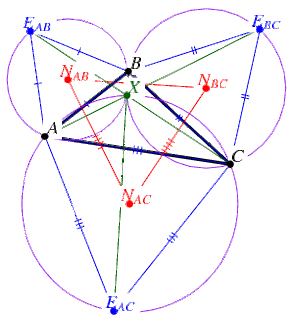
OuterNapoleonsTheorem
If equilateral triangles DeltaABE_(AB), DeltaBCE_(BC), and DeltaACE_(AC) are erected externally on the sides of any triangle DeltaABC, then their centers N_(AB), N_(BC), and N_(AC), respectively, form an equilateral triangle (the outer Napoleon triangle) DeltaN_(AB)N_(BC)N_(AC). An additional property of the externally erected triangles also attributed to Napoleon is that their circumcircles concur in the first Fermat point X (Coxeter 1969, p. 23; Eddy and Fritsch 1994). Furthermore, the lines AE_(BC), BE_(AC), and CE_(AB) connecting the vertices of DeltaABC with the opposite vectors of the erected triangles also concur at X.
This theorem is generally attributed to Napoleon Bonaparte (1769-1821), although it has also been traced back to 1825 (Schmidt 1990, Wentzel 1992, Eddy and Fritsch 1994).

InnerNapoleonsTheorem
Analogous theorems hold when equilateral triangles DeltaABE_(AB)^', DeltaBCE_(BC)^', and DeltaACE_(AC)^' are erected internally on the sides of a triangle DeltaABC. Namely, the inner Napoleon triangle DeltaN_(AB)^'N_(BC)^'N_(AC)^' is equilateral, the circumcircles of the erected triangles intersect in the second Fermat point X^', and the lines connecting the vertices AE_(BC)^', BE_(AC)^', and C^'E_(AB) concur at X^'.
Amazingly, the difference between the areas of the outer and inner Napoleon triangles equals the area of the original triangle (Wells 1991, p. 156).
Drawing the centers of one equilateral triangle inwards and two outwards gives a 30 degrees-30 degrees-120 degrees triangle (Wells 1991, p. 156).
NapoleonsTheoremGen

Napoleon's theorem has a very beautiful generalization in the case of externally constructed triangles: If similar triangles of any shape are constructed externally on a triangle such that each is rotated relative to its neighbors and any three corresponding points of these triangles are connected, the result is a triangle which is similar to the external triangles (Wells 1991, pp. 156-157).
No comments:
Post a Comment
Note: Only a member of this blog may post a comment.